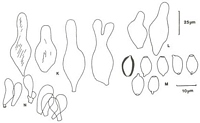|
 Agrocybe acericola Agrocybe acericola
SynonymsAgaricus acericola
BiostatusPresent in region - Exotic
Images (click to enlarge)
Caption: K-N Segedin 1631, K. Pleurocystidia; L. Cheilocystidia; M. Basidiospores; N. Caulocystidia. |
Article: Watling, R.; Taylor, G.M. (1987). Observations on the Bolbitiaceae: 27. Preliminary account of the Bolbitiaceae of New Zealand. Bibliotheca Mycologica 117: 61 p. + 17 pl.
Description: A single collection from New Zealand possibly could be placed here. Unfortunately this collection from Mt Albert, Auckland in PDD (K. R. W. Hammett, 29208) is supported only by scanty field data, viz. (Spores cinnamon brown. Pileus cream, white, smooth, adnate* gills. Stem fibrillose, hollow).
The microscopic data of this collection are: Basidiospores (7.5)8-9 (-9.5) x 4.5-6 µm, ellipsoid, very slightly amygdaliform in side-view, smooth, relatively thick-walled; germ-pore distinct. Basidia 4-spored, 20-22.5 x 5.6 µm. Cheilocystidia collapsed, clavate to vesiculose, 12.5-17.5 x 8-8.5 µm; pleurocystidia not prominent, ventricose with papillate apex or digitate appendages, 35-40 x 13-20.5 µm, apex 3-6 µm broad. Pileipellis a palisadoderm of spheropedunculate cells 15-25.5 µm broad. Gill-margin matted with filamentous flexuous cells 40 µm long resembling those seen in A. parasitica q.v.
Notes: Segedin 1631 (Mt Eden, Auckland, legit Hasnain, 19.IX.1979) had similar basidiospores and cheilocystidia and some pleurocystidia with digitate apices similar both to those figured by Overholts (1927) for A. acericola, and seen in collections by one of us (RW) of the same species from Michigan, USA.
This fungus was originally described as Agaricus (Pholiota) acericolus Peck from wood and trunks of maple (Acer) covered with moss but it is not infrequent in N. America on rotten Acer spp., old trunks of Fagus grandifolia Ehrh. and on piles of sawdust and chips from felling activities in frondose woodland or used as mulching in shrubberies. The Auckland material was on wood-chips and could conceivably have been introduced into New Zealand.
|